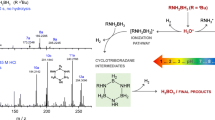Abstract
We report recent progress on the development of a new methodology based on the generation of volatile metal fluorides through the use of nitrogen trifluoride (NF3) and the measurement of these metal fluorides by electron ionization mass spectrometry. Though unreactive under ambient conditions, NF3 reacts selectively at specified temperatures with various metal-containing species to form volatile metal fluorides. Utilizing these species-dependent traits, elements of a sample may be sequentially produced and thus separated on-line. Tellurium was reacted inside a thermogravimetric analyzer, the gas outlet of which was directly coupled to a quadrupole mass spectrometer with an electron impact ionization source.



Similar content being viewed by others
References
Wolf SF (2006) Trace analysis of actinides in geological, environmental, and biological matrices. In: Morss LR, Edelstein NM, Fugar J (eds) The chemistry of the actinide and transactinide elements, vol 5, 3rd edn. Springer, The Netherlands, pp 3273–3338
Condon DJ, McLean N, Noble SR, Bowring SA (2010) Isotopic composition (238U/235U) of some commonly used uranium reference materials. Geochim Cosmochim Acta 74:7127–7143
Balcaen L, Moens L, Vanhaecke F (2010) Determination of isotope ratios of metals (and metalloids) by means of inductively coupled plasma-mass spectrometry for provenancing purposes—a review. Spectrochim Acta B 65:769–786
Boulyga SF, Heumann KG (2006) Determination of extremely low 236U/238U isotope ratios in environmental samples by sector-field inductively coupled plasma mass spectrometry using high-efficiency sample introduction. J Environ Radioact 88:1–10
Hou X, Roos P (2008) Critical comparison of radiometric and mass spectrometric methods for the determination of radionuclides in environmental, biological and nuclear waste samples. Anal Chim Acta 608:105–139
Lariviere D, Taylor VF, Evans RD, Cornett RJ (2006) Radionuclide determination in environmental samples by inductively coupled plasma mass spectrometry. Spectrochim Acta B 61:877–904
Shen C-C, Edwards RL, Cheng H, Dorale JA, Thomas RB, Moran SB, Weinstein SE, Edmonds HN (2002) Uranium and thorium isotopic and concentration measurements by magnetic sector inductively coupled plasma mass spectrometry. Chem Geol 185:165–178
Levitz NM, Anastasia LJ, Carls EL, Chilenskas AA, Graae JAE, Jonke AA, Kessie RA, Larsen RP, Mecham WJ, Ramaswami D, Steindler MJ, Vogel GJ (1969) A conceptual design study of a fluoride-volatility plant for reprocessing LMFBR fuels. Argonne National Laboratory
Inabinett D, Knight T, Adams T, Gray J (2014) Study of XeF2 fluorination potential against Rh2O3, RuO2, ZrO2, and U3O8 for use in reactive gas recycle of used nuclear fuel. Prog Nucl Energy 76:106–111
Mitkin VN, Shavinsky BM (2009) Application of bromine trifluoride for pre-concentration and determination of rare-earth elements in fuel uranium dioxide. J Fluor Chem 130:117–121
Uhlíř J, Mareček M (2009) Fluoride volatility method for reprocessing of LWR and FR fuels. J Fluor Chem 130:89–93
Iwasaki M (1964) Kinetic studies of the fluorination of uranium oxides by fluorine—I. The fluorination of U3O8 and UO3. J Inorg Nucl Chem 26:1853–1861
Labaton VY, Johnson KDB (1959) The fluorides of uranium—III. Kinetic studies of the fluorination of uranium tetrafluoride by fluorine. J Inorg Nucl Chem 10:74–85
Sakurai T (1974) Comparison of the fluorinations of uranium dioxide by bromine trifluoride and elemental fluorine. J Phys Chem 78:1140–1144
Labaton VY (1959) The fluorides of uranium—IV. Kinetic studies of the fluorination of uranium tetrafluoride by chlorine trifluoride. J Inorg Nucl Chem 10:86–93
Gibson JK, Haire RG (1992) High-temperature fluorination studies of uranium, neptunium, plutonium and americium. J Alloys Compd 181:23–32
Bougon R, Cicha WV, Isabey J (1994) Low-temperature fluorination of ruthenium and osmium di- and tetra-oxides. J Fluor Chem 67:271–276
Asprey LB, Eller PG, Kinkead SA (1986) Formation of actinide hexafluorides at ambient temperatures with krypton difluoride. Inorg Chem 25:670–672
Malm JG, Eller PG, Asprey LB (1984) Low-temperature synthesis of plutonium hexafluoride using dioxygen difluoride. J Am Chem Soc 106:2726–2727
McNamara B, Scheele R, Kozelisky A, Edwards M (2009) Thermal reactions of uranium metal, UO2, U3O8, UF4, and UO2F2 with NF3 to produce UF6. J Nucl Mater 394:166–173
Scheele R, McNamara B, Casella AM, Kozelisky A (2012) On the use of thermal NF3 as the fluorination and oxidation agent in treatment of used nuclear fuels. J Nucl Mater 424:224–236
Scheele RD, McNamara BK, Casella AM, Kozelisky AE, Neiner D (2013) Thermal NF3 fluorination/oxidation of cobalt, yttrium, zirconium, and selected lanthanide oxides. J Fluor Chem 146:86–97
McNamara BK, Buck EC, Soderquist CZ, Smith FN, Mausolf EJ, Scheele RD (2014) Separation of metallic residues from the dissolution of a high-burnup BWR fuel using nitrogen trifluoride. J Fluor Chem 162:1–8
Klee MS (2005) GC inlets: an introduction. Agilent Technologies, Inc. Wilmington, DE, Manual part number 5958–9468
Clark RA, McNamara BK, Barinaga CJ, Peterson JM, Govind N, Anderson A, Abrecht DG, Schwantes JM, Ballou NE (2015) Electron ionization mass spectrum of tellurium hexafluoride. Inorg Chem 54:4821–4826
Lide DR (2003–2004) CRC handbook of chemistry and physics, 84th edn. CRC press, Boca Raton
Brooks LS (1952) The vapor pressures of tellurium and selenium. J Am Chem Soc 74:227–229
Acknowledgments
This research funded by Pacific Northwest National Laboratory (PNNL) utilizing Laboratory Directed Research and Development (LDRD) funds. Pacific Northwest National Laboratory is operated by Battelle Memorial Institute for the United States Department of Energy under DOE Contract Number DE-AC05-76RL1830. This research was performed under the Nuclear Forensics Postdoctoral Fellowship Program, which is sponsored by the US Department of Homeland Security, Domestic Nuclear Detection Office and the US Department of Defense, Defense Threat Reduction Agency.
Author information
Authors and Affiliations
Corresponding author
Rights and permissions
About this article
Cite this article
Clark, R.A., Barinaga, C.J., McNamara, B.K. et al. Selective fluorination and separation of metals with NF3 for mass spectrometry. J Radioanal Nucl Chem 307, 1587–1590 (2016). https://doi.org/10.1007/s10967-015-4392-y
Received:
Published:
Issue Date:
DOI: https://doi.org/10.1007/s10967-015-4392-y




